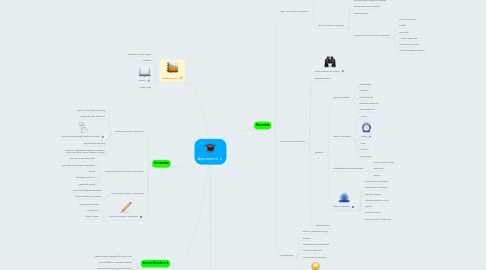
1. Summative
1.1. Planning Summative Assessment
1.1.1. End of a large chunk of learning
1.1.2. Review what you want to do
1.1.3. Criteria for ensuring high-quality assessment
1.1.4. Representative sampling
1.1.5. Examples: Standardized Testing, Final Exams, Major Cumulative Projects, Research Projects
1.2. Preparing Students-Assessment Taking Skills
1.2.1. Teach assessment taking skills
1.2.2. Test length, format, types of questions
1.2.3. Review
1.2.4. Items type and format
1.2.5. Assessment anxiety
1.3. Conducting Summative Assessments
1.3.1. When should they be scheduled?
1.3.2. When should they be created?
1.4. Creating Summative Assessments
1.4.1. Assessment Directions
1.4.2. Arrange Items
1.4.3. Physical Layout
2. Interim/Benchmark
2.1. Periodic testing throughout the school year
2.2. Low-level/little or no student feedback
2.3. More formal style using projects, written assignments, and tests
3. Performance
3.1. Individual or Group Project
3.2. Portfolios
3.3. Journals
3.4. Student Logs
4. Formative
4.1. Types: of Formative Assessment
4.1.1. Informal Formative Assessment
4.1.1.1. Informal Observations
4.1.1.2. Questioning
4.1.1.3. Spontaneous
4.1.1.4. Immediate Feedback and Instructional Adjustments
4.1.2. Formal Formative Assessment
4.1.2.1. Planned activity- individual or groups
4.1.2.2. Specific sequence of activities
4.1.2.3. Pre-assessments
4.1.2.4. 6 Types of Formal Formative Assessment
4.1.2.4.1. Structures Exercises
4.1.2.4.2. Pretests
4.1.2.4.3. Homework
4.1.2.4.4. In Class Assignments
4.1.2.4.5. Quizzes and Unit Tests
4.1.2.4.6. Classroom Response Systems
4.2. Formative Assessment Cycle
4.2.1. Gather Evidence of Learning
4.2.2. Evaluate evidence
4.2.3. Feedback
4.2.3.1. Types of Feedback
4.2.3.1.1. Goal-directed
4.2.3.1.2. Scaffolded
4.2.3.1.3. Self-Referenced
4.2.3.1.4. Standards-Referenced
4.2.3.1.5. Norm-Referenced
4.2.3.2. Nature of Feedback
4.2.3.2.1. Amount
4.2.3.2.2. Timing
4.2.3.2.3. Mode
4.2.3.2.4. Audience
4.2.3.2.5. Type of Task
4.2.3.3. Differentiated Formative Feedback
4.2.3.3.1. Learner Level of Ability
4.2.3.3.2. Grade Level
4.2.3.3.3. Subject
4.2.3.4. Effective Feedback
4.2.3.4.1. Performance to Standards
4.2.3.4.2. Performance to Strategies
4.2.3.4.3. Indicates Progress
4.2.3.4.4. Indicates Corrective Action
4.2.3.4.5. Specific
4.2.3.4.6. Focuses on Errors
4.2.3.4.7. Focuses on Effort Attributions
4.2.4. Adjust instruction
4.3. Characteristics
4.3.1. Evidence of student learning
4.3.2. Structure
4.3.3. Participants involved feedback
4.3.4. Instruction adjistmets
4.3.5. Teacher-student interaction
4.3.6. Attributions for success
